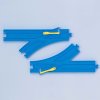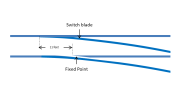On the Railway Accidents Archive is a report
Accident Returns: Extract for the Accident at Mansion House on 30th July 1877
where a train derailed at a set of points.
These points are described as 'fixed' (but not in the never moving sense) and are recognised in the report
as an obsolete and unreliable type.
The only other construction of points/switches I can think of which isn't the familiar blades moving between outer running rails
is what I'd call 'stub points' where the whole two running rails are shifted sideways between two sets of stub ends.
Anybody know?
Accident Returns: Extract for the Accident at Mansion House on 30th July 1877
where a train derailed at a set of points.
These points are described as 'fixed' (but not in the never moving sense) and are recognised in the report
as an obsolete and unreliable type.
The only other construction of points/switches I can think of which isn't the familiar blades moving between outer running rails
is what I'd call 'stub points' where the whole two running rails are shifted sideways between two sets of stub ends.
Anybody know?


